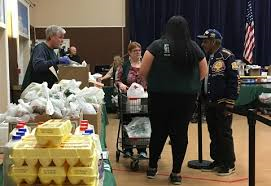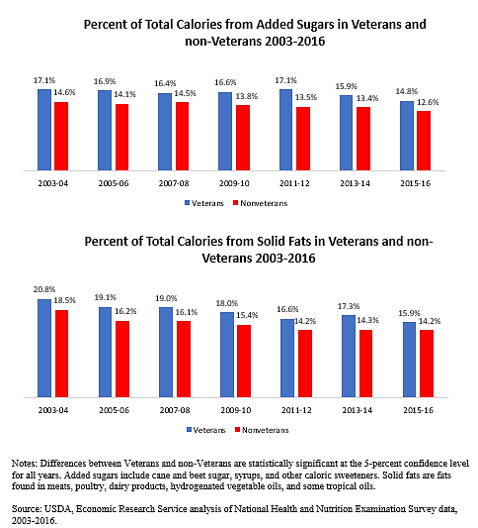Addressing Diet Quality and Food Needs of Veterans
Addressing Diet Quality and Food Needs of Veterans
|
 |
Download PDF
INTRODUCTION
The Veterans Health Administration (VHA) serves a Veteran population that is increasingly diverse. Equitable access to high-quality care for all Veterans is a major tenet of the VA healthcare mission. The Office of Health Equity (OHE) champions the elimination of health disparities and the achievement of health equity for all Veterans.
The Dietary Guidelines for Americans are recommendations for how individuals and their families can consume a healthful and nutritionally adequate diet. The Dietary Guidelines serve as the science-based foundation for vital nutrition policies and programs across the United States.
HEALTH DISPARITIES
Researchers at the Economic Research Service (ERS) at USDA studied how well Veterans’ diets align with the Dietary Guidelines, compared to nonveterans.
Compared with their nonveteran counterparts, Veterans have a higher income and a higher Body Mass Index (BMI), are older, are more likely to be male, and are more likely to be non-Hispanic. Also, Veterans are less likely to closely follow the Dietary Guideline than non-Veterans.
Veterans’ lower diet quality is driven primarily by their consumption of empty calories from added sugars and solid fats. Added sugars include cane and beet sugar, syrups, and other caloric sweeteners, but not naturally occurring sugars such as those in fruits and milk. Solid fats are the fats found in meats, poultry, dairy products, hydrogenated vegetable oils, and some tropical oils.

REDUCING DISPARITIES AND IMPROVING ACCESS
The Office of Health Equity supports research interventions at local VA Medical Centers to reduce health disparities in Veteran groups that are at higher risk for poor health outcomes. This includes ensuring that Veterans are food secure, in that they have access to enough healthy food. VA health-care providers now ask Veterans during their clinic appointments whether they have run out of food or struggled to pay for it within the past three months. If a Veteran says yes, they are then referred to a registered dietitian or social worker so they can receive education to help them manage food resources, be connected to a local food pantry or other community-based program or enrolled in Supplemental Nutrition Assistance. So far VA has screened over 6 million Veterans for food insecurity.
In addition to screening Veterans for food security, VA has established food pantries on VA campuses through a formal partnership between VA and Feeding America. There are food pantries at the following VA Medical Centers:
- Beckley, WV (Mountaineer Food Bank, Beckley VA Medical Center)
- Charleston, SC (Lowcountry Food Bank,
- Ralph H. Johnson VA Medical Center)
- Cincinnati, OH (Freestore Food Bank, Cincinnati VA Medical Center)
- Columbia, SC (Harvest Hope Food Bank, William Jennings Bryan Dorn VA Medical Center)
- Dublin, GA (Middle Georgia Community Food Bank, Carl Vinson VA Medical Center)
- Leavenworth, KS (Second Harvest Community Food Bank, Dwight D. Eisenhower VA Medical Center)
- Martinsburg, WV (Mountaineer Food Bank, Martinsburg VA Medical Center)
- Orlando, FL (Second Harvest Food Bank of Central Florida, Orlando VA Medical Center)
- Spokane, WA (Second Harvest Inland Northwest, Mann-Grandstaff VA Medical Center)
- Temple, TX (Central Texas Food Bank, Central Texas VA Health Care System)
Veterans continue to be screened and more food pantries are being established at VA campuses to ensure that Veterans will have access to healthy food sources.
The full report on Veterans' diet quality can be reached at: https://www.ers.usda.gov/publications/pub-details/?pubid=95608
For more information about the Office of Health Equity visit: https://www.va.gov/healthequity/
For additional OHE fact sheets visit: https://www.va.gov/HEALTHEQUITY/Publications_and_Research.asp
OHE would like to extend a special thanks to the Economic Research Service (ERS) at USDA for their input and guidance.



















